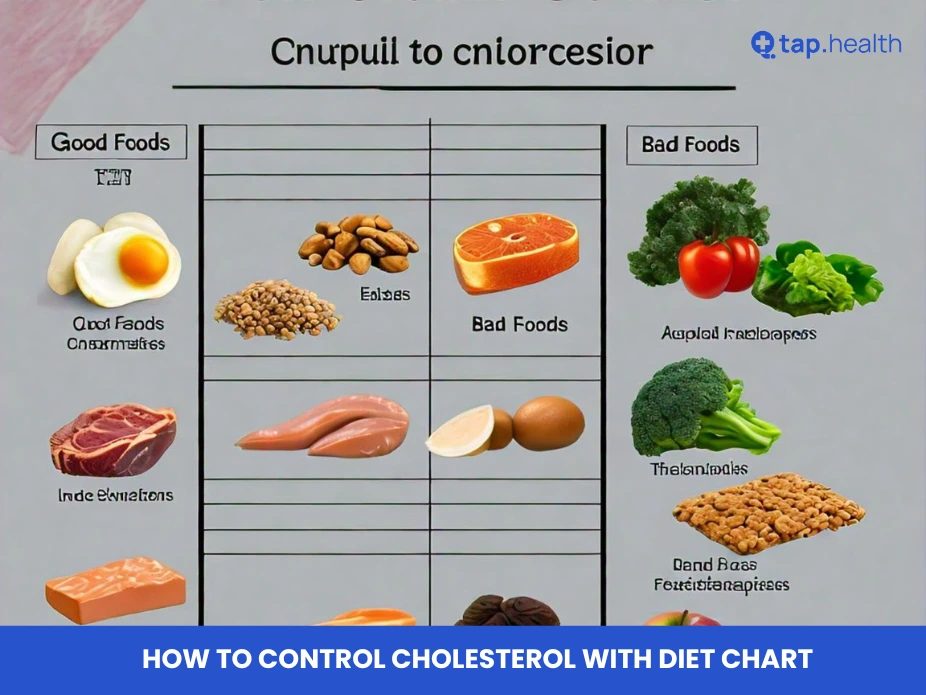Managing cholesterol is crucial for maintaining heart health and preventing diseases. But how can you control cholesterol with a diet chart? Don’t worry; it’s simpler than you think! In this blog, we’ll break down easy-to-follow dietary tips to help you manage your cholesterol levels effectively. Let’s dive in!
Understanding Cholesterol
Before we jump into the diet chart, let’s understand what cholesterol is. Cholesterol is a waxy substance found in your blood. Your body needs it to build healthy cells, but too much cholesterol can increase your risk of heart disease. There are two main types of cholesterol:
- LDL (Low-Density Lipoprotein): Often called “bad” cholesterol, it can build up in your arteries.
- HDL (High-Density Lipoprotein): Known as “good” cholesterol, it helps remove LDL from your arteries.
Keeping LDL low and HDL high is the key to controlling cholesterol.
Creating a Cholesterol-Control Diet Chart
A diet chart helps you plan your meals to include foods that lower LDL and increase HDL. Here’s a simple weekly diet chart to get you started:
Monday
- Breakfast: Oatmeal with fresh berries and a handful of almonds.
- Lunch: Grilled chicken salad with mixed greens, tomatoes, cucumbers, and olive oil dressing.
- Dinner: Baked salmon with steamed broccoli and quinoa.
- Snacks: Apple slices and a small handful of walnuts.
Tuesday
- Breakfast: Whole-grain toast with avocado and a boiled egg.
- Lunch: Lentil soup with a side of whole-grain bread.
- Dinner: Stir-fried tofu with mixed vegetables and brown rice.
- Snacks: Carrot sticks with hummus.
Wednesday
- Breakfast: Greek yogurt with honey and chia seeds.
- Lunch: Turkey and spinach wrap with whole-grain tortilla.
- Dinner: Grilled shrimp with asparagus and wild rice.
- Snacks: A pear and a handful of pistachios.
Thursday
- Breakfast: Smoothie with spinach, banana, and almond milk.
- Lunch: Quinoa salad with black beans, corn, and bell peppers.
- Dinner: Baked chicken breast with sweet potatoes and green beans.
- Snacks: Celery sticks with peanut butter.
Friday
- Breakfast: Whole-grain cereal with skim milk and sliced banana.
- Lunch: Tuna salad with mixed greens and olive oil vinaigrette.
- Dinner: Vegetable stir-fry with tofu and brown rice.
- Snacks: A handful of mixed nuts and an orange.
Saturday
- Breakfast: Scrambled eggs with spinach and whole-grain toast.
- Lunch: Chickpea salad with tomatoes, cucumbers, and feta cheese.
- Dinner: Grilled turkey burger with a side of roasted Brussels sprouts.
- Snacks: Greek yogurt with blueberries.
Sunday
- Breakfast: Pancakes made with whole-grain flour and topped with fresh fruit.
- Lunch: Baked cod with a side of quinoa and steamed vegetables.
- Dinner: Vegetable lasagna with whole-grain noodles.
- Snacks: A banana and a handful of almonds.
Real-Life Scenarios
Scenario 1: Sarah’s Story
Sarah was diagnosed with high cholesterol during a routine check-up. She felt overwhelmed until she consulted a nutritionist who helped her create a diet chart. By incorporating more fruits, vegetables, and whole grains, and reducing red meat and saturated fats, Sarah lowered her LDL levels within six months. She now enjoys cooking healthy meals and feels more energetic.
Scenario 2: John’s Journey
John, a 45-year-old office worker, struggled with high cholesterol due to a sedentary lifestyle and poor eating habits. He decided to follow a cholesterol-control diet chart, focusing on lean proteins, healthy fats, and fiber-rich foods. Coupled with regular exercise, John successfully managed his cholesterol and improved his overall health.
Expert Contributions
Managing cholesterol effectively requires expert guidance. Here are insights from leading professionals in the field:
Dr. Emily Thompson, a cardiologist at the Heart Health Institute, emphasizes the importance of diet in managing cholesterol. “Diet plays a pivotal role in controlling cholesterol levels. Incorporating fiber-rich foods like oats, beans, and fruits can significantly lower LDL levels. Additionally, healthy fats from sources like olive oil and nuts help increase HDL levels,” she explains.
Nutritionist Mark Davis adds, “It’s essential to avoid trans fats and limit saturated fats found in processed foods and red meats. A balanced diet not only manages cholesterol but also promotes overall well-being.”
Dr. Gaurav Sachdeva, a renowned cardiologist in Ludhiana, highlights the role of personalized diet plans. “Every individual’s body responds differently to various foods. It’s important to tailor your diet chart to your specific health needs and cholesterol levels. Regular monitoring and adjustments are key to effective cholesterol management.” You can learn more about Dr. Sachdeva here.
Recommendations Grounded in Proven Research and Facts
Research consistently shows that certain foods can help control cholesterol levels:
- Oats and Whole Grains: Rich in soluble fiber, which reduces LDL cholesterol.
- Fruits and Vegetables: High in fiber and antioxidants, aiding in heart health.
- Healthy Fats: Sources like olive oil, avocados, and nuts improve HDL levels.
- Lean Proteins: Fish, poultry, and plant-based proteins support healthy cholesterol levels.
Incorporating these foods into your diet chart can make a significant difference in managing cholesterol.
Factual and Reliable Information
Controlling cholesterol with diet involves understanding which foods to include and which to avoid. Here are some key points:
- Increase Soluble Fiber: Helps reduce LDL by binding cholesterol in the digestive system. Sources include oats, barley, beans, and lentils.
- Choose Healthy Fats: Replace saturated and trans fats with monounsaturated and polyunsaturated fats found in olive oil, nuts, and fatty fish.
- Limit Dietary Cholesterol: Reduce intake of high-cholesterol foods like red meat, full-fat dairy products, and processed foods.
- Incorporate Plant Sterols and Stanols: These substances, found in fortified foods like certain margarines and orange juice, help block cholesterol absorption.
- Stay Hydrated and Active: Regular physical activity complements a healthy diet in managing cholesterol levels.
For more detailed information, refer to resources like the American Heart Association and National Institutes of Health.
Frequently Asked Questions (FAQ) on How to Control Cholesterol with Diet Chart
1. What is a healthy cholesterol level?
A healthy total cholesterol level is below 200 mg/dL. LDL should be less than 100 mg/dL, and HDL should be 60 mg/dL or higher.
2. Can diet alone control cholesterol?
Yes, for many people, a healthy diet can significantly manage cholesterol levels. However, some may need medications as prescribed by a doctor.
3. What foods should I avoid to lower cholesterol?
Avoid trans fats, found in many processed foods, and limit saturated fats present in red meat and full-fat dairy products.
4. How long does it take to see changes in cholesterol levels?
Changes can be seen in as little as a few weeks, but it typically takes 3 months to notice significant improvements.
5. Are there specific diets recommended for lowering cholesterol?
Diets like the Mediterranean diet, DASH diet, and plant-based diets are effective in managing cholesterol levels.
6. Can exercise help control cholesterol?
Yes, regular physical activity can help raise HDL (good) cholesterol and lower LDL (bad) cholesterol.
7. Should I take supplements to manage cholesterol?
Some supplements, like omega-3 fatty acids, may help, but it’s best to consult with a healthcare provider before starting any supplements.
8. Is weight loss important for controlling cholesterol?
Yes, losing excess weight can help lower LDL cholesterol and increase HDL cholesterol.
9. How often should I get my cholesterol checked?
Adults should have their cholesterol checked every 4-6 years, or more frequently if they have risk factors for heart disease.
10. Can stress affect my cholesterol levels?
Chronic stress may contribute to higher cholesterol levels, so managing stress is important for overall heart health.
Conclusion
Controlling cholesterol with a diet chart is a practical and effective way to maintain heart health. By incorporating fiber-rich foods, healthy fats, and lean proteins, while avoiding unhealthy fats and processed foods, you can manage your cholesterol levels naturally. Remember to stay active, maintain a healthy weight, and consult with healthcare professionals to tailor a diet plan that suits your needs. Start your journey towards a healthier heart today!



